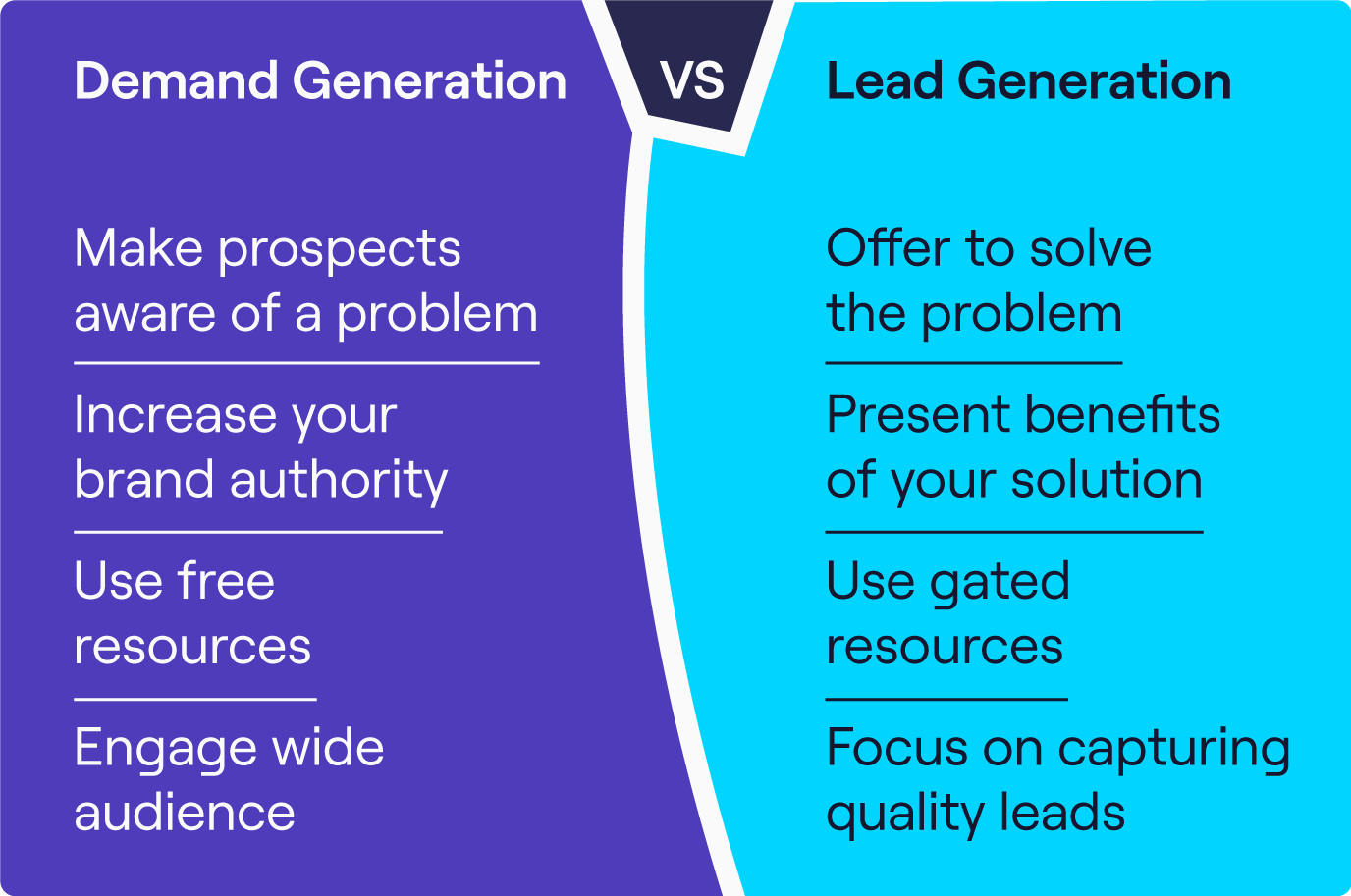Demand generation focuses on creating awareness and interest, while lead generation involves identifying potential customers. Both strategies aim to drive revenue growth for businesses by nurturing relationships with prospects and converting them into paying customers.
Demand generation encompasses broader marketing initiatives, such as branding and content marketing, to generate interest in a product or service. On the other hand, lead generation is more focused on capturing specific information about potential leads, qualifying them, and handing them over to the sales team for further engagement.
By understanding the distinctions between demand generation and lead generation, businesses can optimize their marketing efforts to attract and convert high-quality leads effectively.

Credit: terakeet.com
Key Differences Between Demand Generation And Lead Generation
Key Differences Between Demand Generation and Lead Generation
The terms “demand generation” and “lead generation” are often used interchangeably, but they refer to distinct strategies within the marketing and sales funnel. Understanding the differences between demand generation and lead generation is crucial for businesses to effectively drive traffic, generate leads, and convert them into customers.
Definition And Focus
Demand Generation: Demand generation encompasses all marketing activities aimed at creating awareness, interest, and consideration for a company’s products or services. It focuses on generating demand for the overall brand and nurturing leads throughout their buyer’s journey.
Lead Generation: On the other hand, lead generation refers to the specific tactics implemented to identify and capture potential customers’ contact information, turning them into actionable leads. The primary goal of lead generation is to acquire contact details, such as email addresses or phone numbers, that can be used for direct sales outreach.
Strategies And Tactics
Demand Generation: Demand generation strategies usually involve content marketing, social media engagement, search engine optimization (SEO), webinars, events, and other awareness-building initiatives. Tactics may include creating engaging blog posts, sharing informative videos, running targeted ads campaigns, and implementing lead magnets like whitepapers or ebooks.
Lead Generation: Lead generation strategies, on the other hand, typically focus on capturing leads’ contact information through various tactics such as gated content, lead capture forms, landing pages, and email marketing campaigns. Specialized lead generation tools like pop-ups, chatbots, and lead capture widgets are commonly used tactics to collect valuable lead data.
Target Audience
Demand Generation: The primary audience for demand generation is broad and encompasses all potential buyers who may have an interest in the product or service. It aims to create widespread brand awareness and attract a wide audience, including those who may not be actively looking for a solution.
Lead Generation: In contrast, lead generation targets a more specific audience: individuals or companies who have shown an expressed interest in a product or service. This audience is actively seeking a solution to their problem, making them more likely to convert into leads or customers.
Metrics For Success
Demand Generation: Metrics for measuring demand generation success typically include website traffic, social media engagement, brand mentions, and overall brand sentiment. These metrics help assess the effectiveness of awareness-building efforts and the impact on brand recognition.
Lead Generation: On the other hand, lead generation success is often measured by the number and quality of leads captured. Metrics such as lead conversion rate, cost per lead, lead-to-customer ratio, and return on investment (ROI) provide insights into the efficiency of lead generation efforts and directly tie outcomes to revenue generation.
Optimal Integration
Demand Generation: Demand generation and lead generation are not mutually exclusive strategies. In fact, they often work hand in hand to drive business growth. By integrating demand generation efforts with lead generation tactics, businesses can maintain a steady flow of leads while simultaneously building brand awareness and capturing potential customers earlier in their decision-making process.
Lead Generation: Effective lead generation requires a solid foundation of demand generation initiatives. Without demand generation efforts, lead generation may struggle to find qualified leads or fail to capture the attention of potential customers. Therefore, integrating the two strategies is essential for maximizing marketing and sales success.

Credit: clearbit.com

Credit: www.cognism.com
Frequently Asked Questions For What Is The Difference Between Demand Generation And Lead Generation
What Is From Lead Generation To Demand Generation?
Lead generation focuses on capturing potential customer data, while demand generation nurtures and educates leads to drive sales.
What Is The Difference Between Demand Generation And Brand Generation?
Demand generation drives immediate sales, while brand generation focuses on long-term brand loyalty and awareness.
What Is Meant By Demand Generation?
Demand generation refers to marketing strategies aimed at creating interest and generating demand for a product or service.
What Is Lead Gen Vs Demand Gen Linkedin?
Lead gen on LinkedIn involves capturing potential customer’s contact information, focusing on increasing sales prospects. In contrast, demand gen centers on building brand awareness and generating interest in products or services. Both strategies are essential for a comprehensive marketing approach on LinkedIn.
Conclusion
In essence, demand generation creates interest, while lead generation captures potential customers’ information. Both are essential for a successful marketing strategy. Understanding the difference between the two techniques can significantly improve your marketing efforts and help to create a more targeted and effective approach to acquiring new customers.




